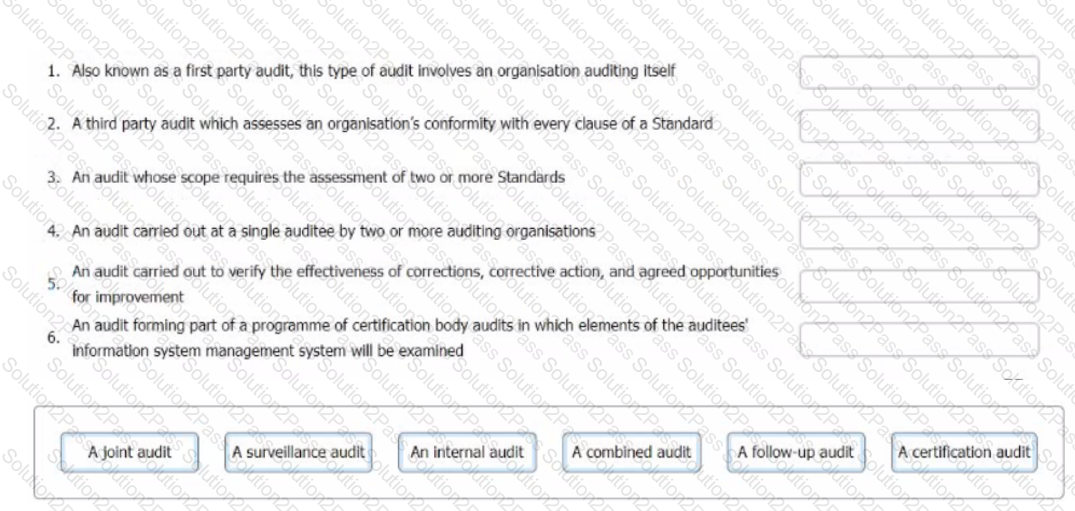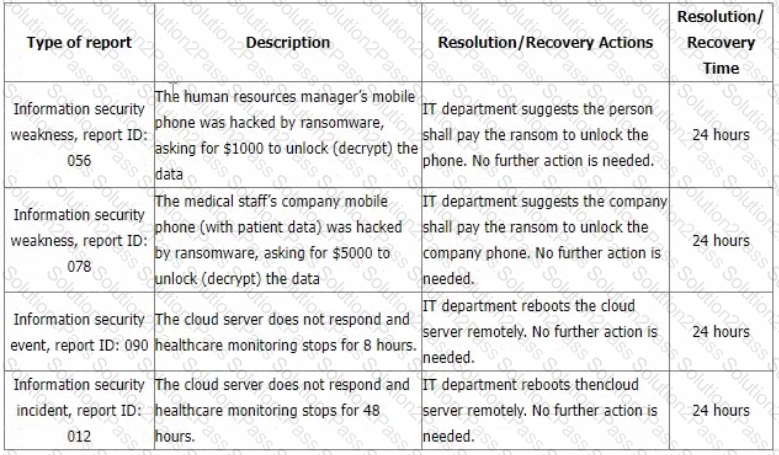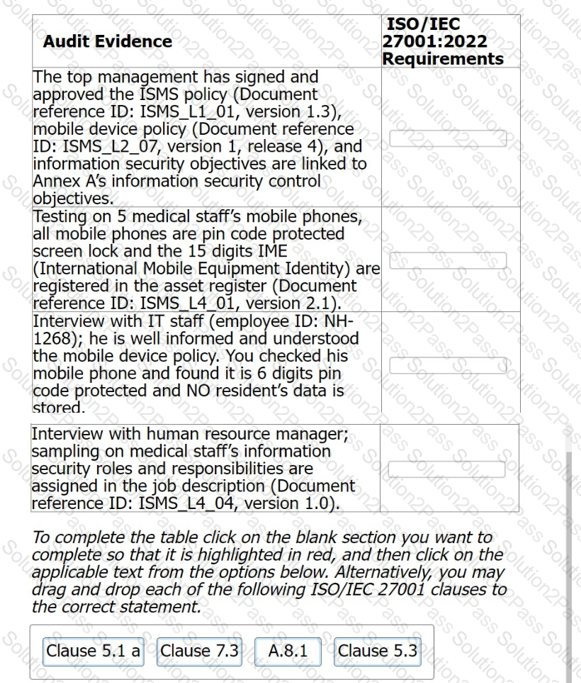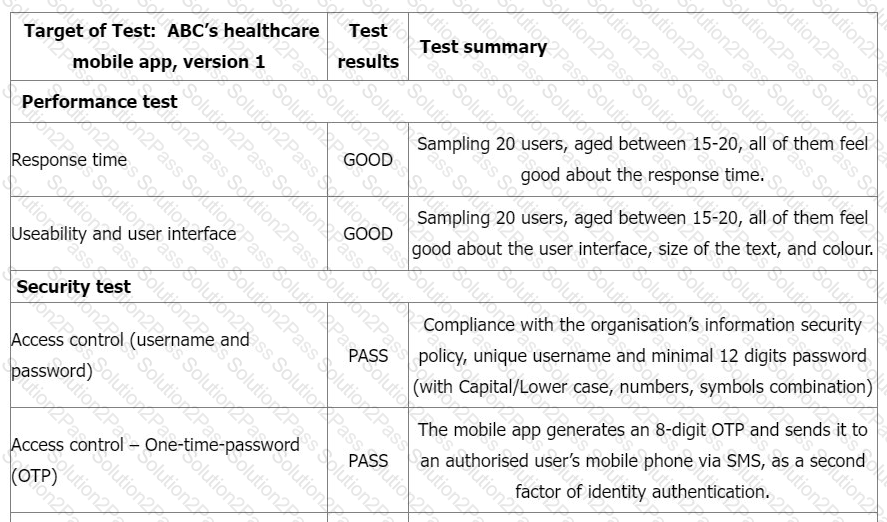ISO-IEC-27001-Lead-Auditor PECB Certified ISO/IEC 27001 2022 Lead Auditor exam Free Practice Exam Questions (2025 Updated)
Prepare effectively for your PECB ISO-IEC-27001-Lead-Auditor PECB Certified ISO/IEC 27001 2022 Lead Auditor exam certification with our extensive collection of free, high-quality practice questions. Each question is designed to mirror the actual exam format and objectives, complete with comprehensive answers and detailed explanations. Our materials are regularly updated for 2025, ensuring you have the most current resources to build confidence and succeed on your first attempt.
Total 368 questions
You are an experienced ISMS audit team leader. An auditor in training has approached you to ask you to clarify the different types of audits she may be required to undertake.
Match the following audit types to the descriptions.
To complete the table click on the blank section you want to complete so that It is highlighted In fed, and then click on the applicable text from the options below. Alternatively, you may drag and drop each option to the appropriate blank section.

You receive the following mail from the IT support team: Dear User,Starting next week, we will be deleting all inactive email accounts in order to create spaceshare the below details in order to continue using your account. In case of no response,
Name:
Email ID:
Password:
DOB:
Kindly contact the webmail team for any further support. Thanks for your attention.
Which of the following is the best response?
-------------------------is an asset like other important business assets has value to an organization and consequently needs to be protected.
You are an experienced ISMS audit team leader guiding an auditor in training. You decide to test her knowledge of follow-up audits by asking her a series of questions. Here are your questions and her answers.
Which four of your questions has she answered correctly?
Which option below about the ISMS scope is correct?
Why should materiality be considered during the initial contact?
Which two of the following options are an advantage of using a sampling plan for the audit?
You see a blue color sticker on certain physical assets. What does this signify?
You are performing an ISMS audit at a residential nursing home that provides healthcare services. The next step in your audit plan is to verify the information security incident management process. The IT Security Manager presents the information security incident management procedure and explains that the process is based on ISO/IEC 27035-1:2016.
You review the document and notice a statement "any information security weakness, event, and incident should be reported to the Point of Contact (PoC) within 1 hour after identification". When interviewing staff, you found that there were differences in the understanding of the meaning of "weakness, event, and incident".
You sample incident report records from the event tracking system for the last 6 months with summarized results in the following table.

You would like to further investigate other areas to collect more audit evidence. Select two options that will not be in your audit trail.
Which two of the following options do not participate in a first-party audit?
You are performing an ISMS audit at a European-based residential
nursing home called ABC that provides healthcare services. You find all
nursing home residents wear an electronic wristband for monitoring
their location, heartbeat, and blood pressure always. You learned that
the electronic wristband automatically uploads all data to the artificial
intelligence (AI) cloud server for healthcare monitoring and analysis by
healthcare staff.
The next step in your audit plan is to verify that the information security
policy and objectives have been established by top management.
During the audit, you found the following audit evidence.
Match the audit evidence to the corresponding requirement in ISO/IEC 27001:2022.

Scenario 5: Cobt. an insurance company in London, offers various commercial, industrial, and life insurance solutions. In recent years, the number of Cobt's clients has increased enormously. Having a huge amount of data to process, the company decided that certifying against ISO/IEC 27001 would bring many benefits to securing information and show its commitment to continual improvement. While the company was well-versed in conducting regular risk assessments, implementing an ISMS brought major changes to its daily operations. During the risk assessment process, a risk was identified where significant defects occurred without being detected or prevented by the organizations internal control mechanisms.
The company followed a methodology to implement the ISMS and had an operational ISMS in place after only a few months After successfully implementing the ISMS, Cobt applied for ISO/IEC 27001 certification Sarah, an experienced auditor, was assigned to the audit Upon thoroughly analyzing the audit offer, Sarah accepted her responsibilities as an audit team leader and immediately started to obtain general information about Cobt She established the audit criteria and objective, planned the audit, and assigned the audit team members' responsibilities.
Sarah acknowledged that although Cobt has expanded significantly by offering diverse commercial and insurance solutions, it still relies on some manual processes Therefore, her initial focus was to gather information on how the company manages its information security risks Sarah contacted Cobt's representatives to request access to information related to risk management for the off-site review, as initially agreed upon for part of the audit However, Cobt later refused, claiming that such information is too sensitive to be accessed outside of the company This refusal raised concerns about the audit's feasibility, particularly regarding the availability and cooperation of the auditee and access to evidence Moreover, Cobt raised concerns about the audit schedule, stating that it does not properly reflect the recent changes the company made It pointed out that the actions to be performed during the audit apply only to the initial scope and do not encompass the latest changes made in the audit scope
Sarah also evaluated the materiality of the situation, considering the significance of the information denied for the audit objectives. In this case, the refusal by Cobt raised questions about the completeness of the audit and its ability to provide reasonable assurance. Following these situations, Sarah decided to withdraw from the audit before a certification agreement was signed and communicated her decision to Cobt and the certification body. This decision was made to ensure adherence to audit principles and maintain transparency, highlighting her commitment to consistently upholding these principles.
Based on the scenario above, answer the following question:
Question:
Based on the information provided in Scenario 5, Cobt refused to provide the auditors with information on risk management. How would you, as an auditor, resolve such a situation?
As an auditor, you have noticed that ABC Inc. has established a procedure to manage the removable storage media. The procedure is based on the classification scheme adopted by ABC Inc. Thus, if the information stored is classified as "confidential," the procedure applies. On the other hand, the information that is classified as "public," does not have confidentiality requirements: thus, only a procedure for ensuring its integrity and availability applies. What type of audit finding is this?
You are performing an ISMS audit at a residential nursing home called ABC that provides healthcare services.
The next step in your audit plan is to verify the information security of ABC's healthcare mobile app development, support, and lifecycle process. During the audit, you learned the organisation outsourced the mobile app development to a professional software development organisation with CMMI Level 5, ITSM
(ISO/IEC 20000-1), BCMS (ISO 22301) and ISMS (ISO/IEC 27001) certified.
The IT Manager presents the software security management procedure and summarises the process as follows:
The mobile app development shall adopt "security-by-design" and "security-by-default" principles, as a minimum. The following security functions for personal data protection shall be available:
Access control.
Personal data encryption, i.e., Advanced Encryption Standard (AES) algorithm, key lengths: 256 bits; and
Personal data pseudonymization.
Vulnerability checked and no security backdoor
You sample the latest Mobile App Test report - Reference ID: 0098, details as follows:


You would like to investigate other areas further to collect more audit evidence. Select three options that will not be in your audit trail.
Scenario 3: Rebuildy is a construction company located in Bangkok.. Thailand, that specializes in designing, building, and maintaining residential buildings. To ensure the security of sensitive project data and client information, Rebuildy decided to implement an ISMS based on ISO/IEC 27001. This included a comprehensive understanding of information security risks, a defined continual improvement approach, and robust business solutions.
The ISMS implementation outcomes are presented below
•Information security is achieved by applying a set of security controls and establishing policies, processes, and procedures.
•Security controls are implemented based on risk assessment and aim to eliminate or reduce risks to an acceptable level.
•All processes ensure the continual improvement of the ISMS based on the plan-do-check-act (PDCA) model.
•The information security policy is part of a security manual drafted based on best security practices Therefore, it is not a stand-alone document.
•Information security roles and responsibilities have been clearly stated in every employees job description
•Management reviews of the ISMS are conducted at planned intervals.
Rebuildy applied for certification after two midterm management reviews and one annual internal audit Before the certification audit one of Rebuildy’s former employees approached one of the audit team members to tell them that Rebuildy has several security problems that the company is trying to conceal. The former employee presented the documented evidence to the audit team member Electra, a key client of Rebuildy, also submitted evidence on the same issues, and the auditor determined to retain this evidence instead of the former employee's. The audit team member remained in contact with Electra until the audit was completed, discussing the nonconformities found during the audit. Electra provided additional evidence to support these findings.
At the beginning of the audit, the audit team interviewed the company’s top management They discussed, among other things, the top management's commitment to the ISMS implementation. The evidence obtained from these discussions was documented in written confirmation, which was used to determine Rebuildy’s conformity to several clauses of ISO/IEC 27001
The documented evidence obtained from Electra was attached to the audit report, along with the nonconformities report. Among others, the following nonconformities were detected:
•An instance of improper user access control settings was detected within the company's financial reporting system.
•A stand-alone information security policy has not been established. Instead, the company uses a security manual drafted based on best security practices.
After receiving these documents from the audit team, the team leader met Rebuildy’s top management to present the audit findings. The audit team reported the findings related to the financial reporting system and the lack of a stand-alone information security policy. The top management expressed dissatisfaction with the findings and suggested that the audit team leader's conduct was unprofessional, implying they might request a replacement. Under pressure, the audit team leader decided to cooperate with top management to downplay the significance of the detected nonconformities. Consequently, the audit team leader adjusted the report to present a more favorable view, thus misrepresenting the true extent of Rebuildy's compliance issues.
Based on the scenario above, answer the following question:
Question:
Based on Scenario 3, the audit team used information obtained from interviews with top management to determine Rebuildy’s conformity to several ISO/IEC 27001 clauses. Is this acceptable?
Scenario 6: Sinvestment is an insurance company that offers home, commercial, and life insurance. The company was founded in North Carolina, but have recently expanded in other locations, including Europe and Africa.
Sinvestment is committed to complying with laws and regulations applicable to their industry and preventing any information security incident. They have implemented an ISMS based on ISO/IEC 27001 and have applied for ISO/IEC 27001 certification.
Two auditors were assigned by the certification body to conduct the audit. After signing a confidentiality agreement with Sinvestment. they started the audit activities. First, they reviewed the documentation required by the standard, including the declaration of the ISMS scope, information security policies, and internal audits reports. The review process was not easy because, although Sinvestment stated that they had a documentation procedure in place, not all documents had the same format.
Then, the audit team conducted several interviews with Sinvestment's top management to understand their role in the ISMS implementation. All activities of the stage 1 audit were performed remotely, except the review of documented information, which took place on-site, as requested by Sinvestment.
During this stage, the auditors found out that there was no documentation related to information security training and awareness program. When asked, Sinvestment's representatives stated that the company has provided information security training sessions to all employees. Stage 1 audit gave the audit team a general understanding of Sinvestment's operations and ISMS.
The stage 2 audit was conducted three weeks after stage 1 audit. The audit team observed that the marketing department (which was not included in the audit scope) had no procedures in place to control employees’ access rights. Since controlling employees' access rights is one of the ISO/IEC 27001 requirements and was included in the information security policy of the company, the issue was included in the audit report. In addition, during stage 2 audit, the audit team observed that Sinvestment did not record logs of user activities. The procedures of the company stated that "Logs recording user activities should be retained and regularly reviewed," yet the company did not present any evidence of the implementation of such procedure.
During all audit activities, the auditors used observation, interviews, documented information review, analysis, and technical verification to collect information and evidence. All the audit findings during stages 1 and 2 were analyzed and the audit team decided to issue a positive recommendation for certification.
Based on scenario 6, during stage 1 audit, the auditor found out that some documents regarding the ISMS had different format. What should the auditor do in this case?
An organization does not check the source code of the updated version of an application when it is updated automatically. Thus, the application may be open to
unauthorized modifications. This represents a _________________ that may impact information ___________________
You have a hard copy of a customer design document that you want to dispose off. What would you do
Scenario 7: Lawsy is a leading law firm with offices in New Jersey and New York City. It has over 50 attorneys offering sophisticated legal services to clients in business and commercial law, intellectual property, banking, and financial services. They believe they have a comfortable position in the market thanks to their commitment to implement information security best practices and remain up to date with technological developments.
Lawsy has implemented, evaluated, and conducted internal audits for an ISMS rigorously for two years now. Now, they have applied for ISO/IEC 27001 certification to ISMA, a well-known and trusted certification body.
During stage 1 audit, the audit team reviewed all the ISMS documents created during the implementation. They also reviewed and evaluated the records from management reviews and internal audits.
Lawsy submitted records of evidence that corrective actions on nonconformities were performed when necessary, so the audit team interviewed the internal auditor. The interview validated the adequacy and frequency of the internal audits by providing detailed insight into the internal audit plan and procedures.
The audit team continued with the verification of strategic documents, including the information security policy and risk evaluation criteria. During the information security policy review, the team noticed inconsistencies between the documented information describing governance framework (i.e., the information security policy) and the procedures.
Although the employees were allowed to take the laptops outside the workplace, Lawsy did not have procedures in place regarding the use of laptops in such cases. The policy only provided general information about the use of laptops. The company relied on employees' common knowledge to protect the confidentiality and integrity of information stored in the laptops. This issue was documented in the stage 1 audit report.
Upon completing stage 1 audit, the audit team leader prepared the audit plan, which addressed the audit objectives, scope, criteria, and procedures.
During stage 2 audit, the audit team interviewed the information security manager, who drafted the information security policy. He justified the Issue identified in stage 1 by stating that Lawsy conducts mandatory information security training and awareness sessions every three months.
Following the interview, the audit team examined 15 employee training records (out of 50) and concluded that Lawsy meets requirements of ISO/IEC 27001 related to training and awareness. To support this conclusion, they photocopied the examined employee training records.
Based on the scenario above, answer the following question:
The audit team photocopied the examined employee training records to support their conclusion. Should the audit team obtain an approval from Lawsy before taking this action? Refer to scenario 7.
Scenario 8: Tessa. Malik, and Michael are an audit team of independent and qualified experts in the field of security, compliance, and business planning and strategies. They are assigned to conduct a certification audit in Clastus, a large web design company. They have previously shown excellent work ethics, including impartiality and objectiveness, while conducting audits. This time, Clastus is positive that they will be one step ahead if they get certified against ISO/IEC 27001.
Tessa, the audit team leader, has expertise in auditing and a very successful background in IT-related issues, compliance, and governance. Malik has an organizational planning and risk management background. His expertise relies on the level of synthesis and analysis of an organization's security controls and its risk tolerance in accurately characterizing the risk level within an organization On the other hand, Michael is an expert in the practical security of controls assessment by following rigorous standardized programs.
After performing the required auditing activities, Tessa initiated an audit team meeting They analyzed one of Michael s findings to decide on the issue objectively and accurately. The issue Michael had encountered was a minor nonconformity in the organization's daily operations, which he believed was caused by one of the organization's IT technicians As such, Tessa met with the top management and told them who was responsible for the nonconformity after they inquired about the names of the persons responsible
To facilitate clarity and understanding, Tessa conducted the closing meeting on the last day of the audit. During this meeting, she presented the identified nonconformities to the Clastus management. However, Tessa received advice to avoid providing unnecessary evidence in the audit report for the Clastus certification audit, ensuring that the report remains concise and focused on the critical findings.
Based on the evidence examined, the audit team drafted the audit conclusions and decided that two areas of the organization must be audited before the certification can be granted. These decisions were later presented to the auditee, who did not accept the findings and proposed to provide additional information. Despite the auditee's comments, the auditors, having already decided on the certification recommendation, did not accept the additional information. The auditee's top management insisted that the audit conclusions did not represent reality, but the audit team remained firm in their decision.
Based on the scenario above, answer the following question:
Question:
What must Tessa do regarding the presentation of nonconformities during the closing meeting?
Total 368 questions


